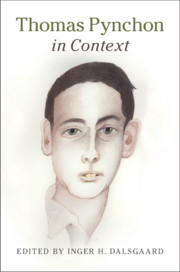Book contents
- Thomas Pynchon in Context
- Thomas Pynchon in Context
- Copyright page
- Contents
- Contributors
- Abbreviations
- Chronology
- Introduction
- Part I Times and Places
- Chapter 1 Biography
- Chapter 2 Letters and Juvenilia
- Chapter 3 Nonfiction
- Chapter 4 East Coast
- Chapter 5 West Coast
- Chapter 6 Europe and Asia
- Chapter 7 Africa and Latin America
- Chapter 8 Geographies and Mapping
- Chapter 9 The Eighteenth Century
- Chapter 10 The Nineteenth Century
- Chapter 11 The Twentieth Century
- Chapter 12 The Twenty-First Century
- Chapter 13 History and Metahistory
- Part II Culture, Politics, and Society
- Part III Approaches and Readings
- Further Reading
- Index
Chapter 6 - Europe and Asia
from Part I - Times and Places
Published online by Cambridge University Press: 31 May 2019
- Thomas Pynchon in Context
- Thomas Pynchon in Context
- Copyright page
- Contents
- Contributors
- Abbreviations
- Chronology
- Introduction
- Part I Times and Places
- Chapter 1 Biography
- Chapter 2 Letters and Juvenilia
- Chapter 3 Nonfiction
- Chapter 4 East Coast
- Chapter 5 West Coast
- Chapter 6 Europe and Asia
- Chapter 7 Africa and Latin America
- Chapter 8 Geographies and Mapping
- Chapter 9 The Eighteenth Century
- Chapter 10 The Nineteenth Century
- Chapter 11 The Twentieth Century
- Chapter 12 The Twenty-First Century
- Chapter 13 History and Metahistory
- Part II Culture, Politics, and Society
- Part III Approaches and Readings
- Further Reading
- Index
Summary
Although he is described as an American writer, virtually all of Thomas Pynchon’s texts transport the reader around the globe, interrogating along the way the permeable boundary between visible and imaginary worlds that writing and representation foreground. Indeed, his books rarely follow Aristotelian notions of plot with beginnings, middles, and ends, or conceive matter as a timeless and universal substance. Instead, his literature focuses on what he calls the “knotting into” (GR 3) of differing lines of force: discontinuous histories, narratives, natural and supernatural forces, political and social elements, events, myths, spaces, places, and people that through their dynamic interaction construct the compendia of plots, characters, and vignettes that comprise his books. Pynchon offers a telling statement on his method in a blurb for Against the Day (2006): “The author is up to his usual business […] Contrary-to-the-fact occurrences occur. If it is not the world, it is what the world might be with an adjustment or two. According to some, this is one of the main purposes of fiction.” Pynchon’s novels are, therefore, alternative maps of the world, of possible existences that demonstrate how reality emerges through the convergence of social, historical, and linguistic forces, producing people’s realities within and beyond the frames of nation-states that ultimately organize and differentiate them in the world. Taking Pynchon’s statement seriously, we will focus on his speculative imagining of alternative histories within Europe and Asia, speaking not only to the geographical locales produced as effects of power relations that we live through current geopolitical maps but also the leakages of history – the people who resist these techniques of power designed to limit and control their lives.
- Type
- Chapter
- Information
- Thomas Pynchon in Context , pp. 47 - 56Publisher: Cambridge University PressPrint publication year: 2019



